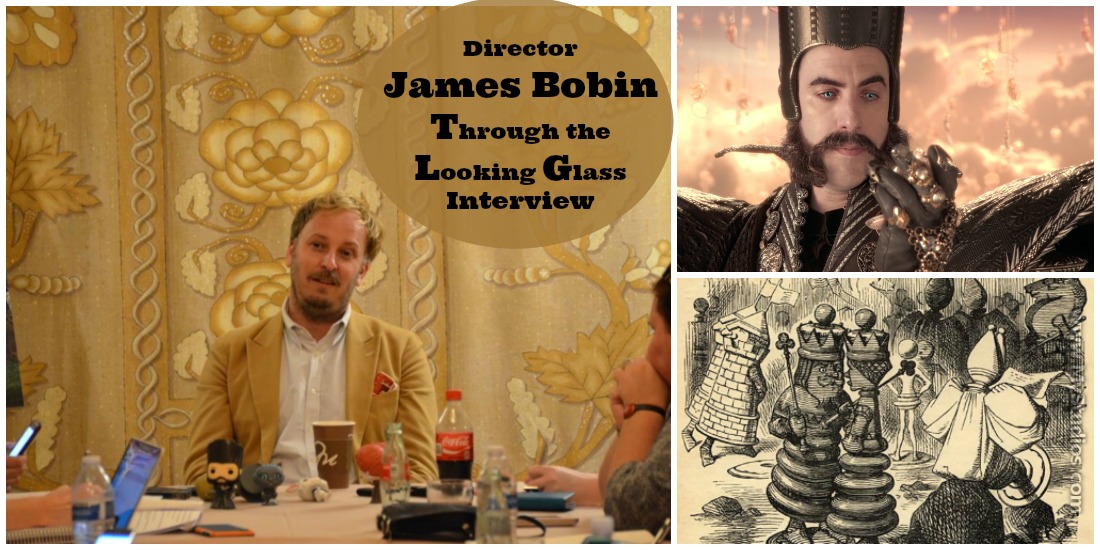
I interviewed James Bobin a few years ago for his work on The Muppets Most Wanted. He was so much fun to interview for he’s the perfect sorta soul for a task like that, and even more perfect to be in the footsteps of Tim Burton for the new Alice movie, Through the Looking Glass.
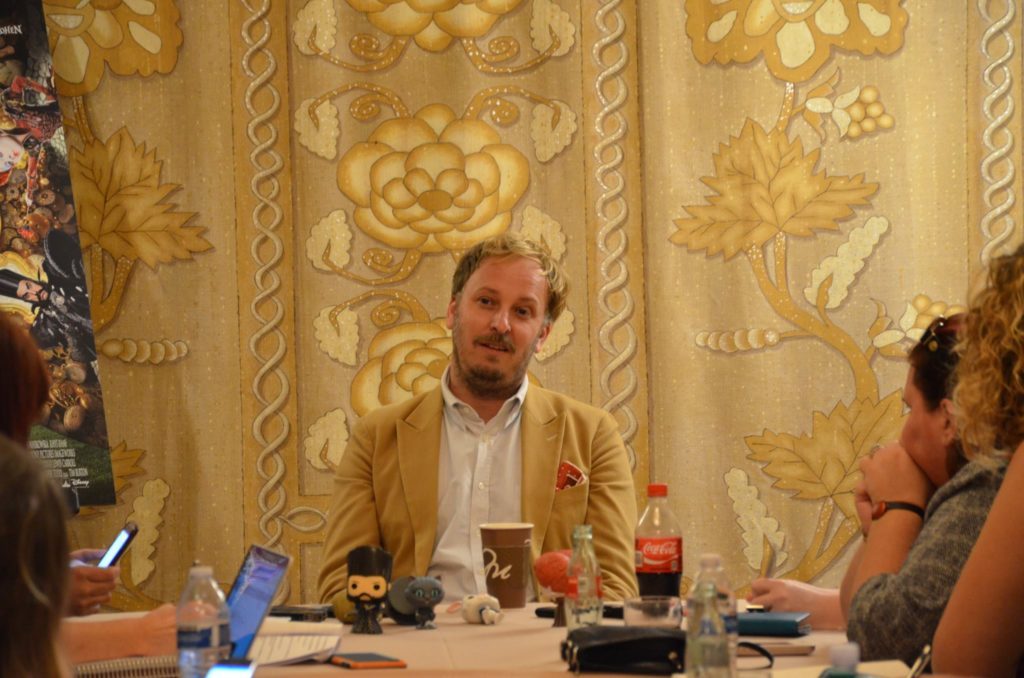
Director James Bobin: Through the Looking Glass Interview
James walks into a room full of applause, and he is at ease in his story-telling element. We begin talking about the 3-year process of making Alice Through the Looking Glass.
So nearly three years in total. But that’s right from the very first conversation I had about the film at all, in terms of like even attempting to do it. Then obviously it’s a presence where I only finished it like a month ago. I finished editing the final 3-D images a month ago because it takes a long time. And we shot at Shepperton Studios in London in 2014. So even that was two years ago. So, yeah, it’s a long time.
How did you get attached to the project?
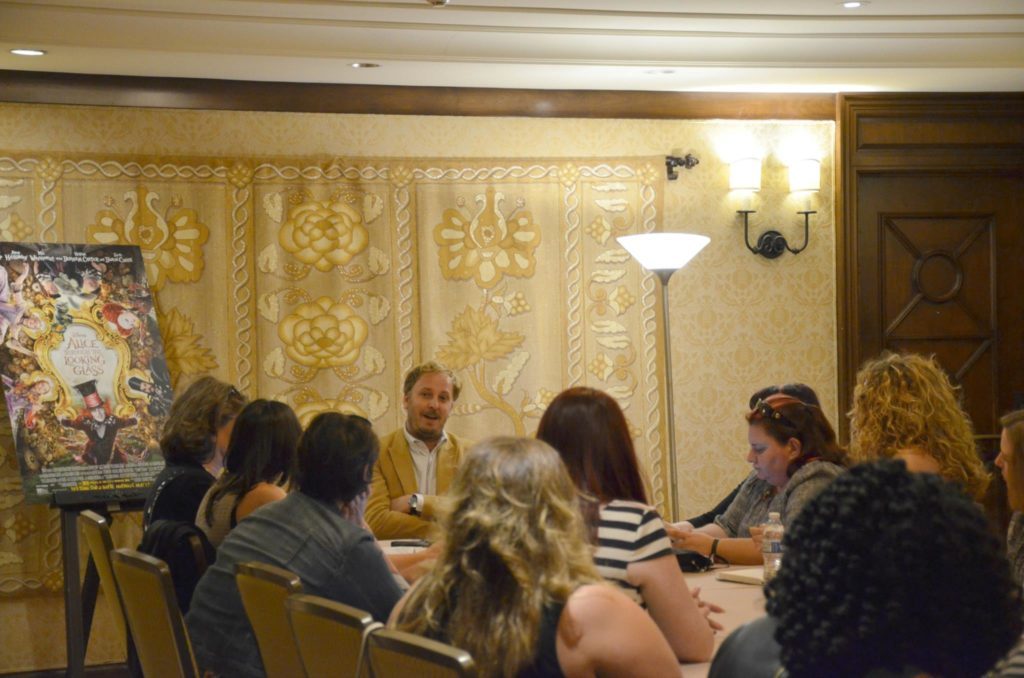 I was working for Disney already. I made some Muppets movies for them back in the day. And that was fun. I remember being on set, with my executive producer. She was talking about things they were thinking about doing. And she mentioned the word Alice to me. And of course, I jumped at that because I grew up in England. And so Alice is like part of your life. Like she’s just someone who you know well. She’s like Christopher Robin. She’s just like part of your makeup. Like for me, my parents read it to me. I read it as a kid. My grandparents read it to me. Everyone has it. And so for me, I did the same with my children. I have in my kid’s playroom; we have a poster from the British Library, which is the front piece of the original manuscript at home. Just a copy. But it’s beautiful. So it’s the thing he wrote for Alice Little. And it’s the first page. And it has his little drawings, which are very different to the way you think she’s going to look. It’s like Lewis Carroll drawings for Alice Little. And it’s really pretty. So we love Alice in our family. So when I found out we were doing, I was really excited because when you know something it’s a quite good way for starting it. You think you have a clear idea of who she’s gonna be in the film. And who I felt Alice was to me growing up. But also ’cause I keep saying when I read Lewis Carroll as a kid he used to make me laugh. He has a very witty way of writing. And he’s very clever with language. And, oh, I think comedy is often about the specificity of language. And so for me, all my life so far I’ve been making jokes and comedy. And so it felt like a very natural thing to do is try and use that in this world ’cause obviously, Tim’s thing is so beautiful and so beautifully constructed. That was a really good foundation to start from. But I thought if I came on that I could kind of bring some of that British comedy back a bit, which is hopefully what you guys saw when you watched the movie. So it’s a bit different. I mean it needed to be different. I think sequels need to be different. It’s nice to pay tribute and make sure you respect the origins of the story and the characters. But people want to see generally something which is a progression or something new or if it has a different sight, feel or tone. And so you’ll notice that in the design it’s a bit different too. The palettes are a little bit brighter. In the movie, the story itself is very much about the human relations and the family. And so we have a lot more, I guess, like photo-real design. Like the world is more Victorian in some ways. And that’s partly because when I was a kid growing up the books are illustrated by a guy called John Tenniel, who’s like an unbelievably beautiful engraving. And that to me was where the world where Alice lived.
I was working for Disney already. I made some Muppets movies for them back in the day. And that was fun. I remember being on set, with my executive producer. She was talking about things they were thinking about doing. And she mentioned the word Alice to me. And of course, I jumped at that because I grew up in England. And so Alice is like part of your life. Like she’s just someone who you know well. She’s like Christopher Robin. She’s just like part of your makeup. Like for me, my parents read it to me. I read it as a kid. My grandparents read it to me. Everyone has it. And so for me, I did the same with my children. I have in my kid’s playroom; we have a poster from the British Library, which is the front piece of the original manuscript at home. Just a copy. But it’s beautiful. So it’s the thing he wrote for Alice Little. And it’s the first page. And it has his little drawings, which are very different to the way you think she’s going to look. It’s like Lewis Carroll drawings for Alice Little. And it’s really pretty. So we love Alice in our family. So when I found out we were doing, I was really excited because when you know something it’s a quite good way for starting it. You think you have a clear idea of who she’s gonna be in the film. And who I felt Alice was to me growing up. But also ’cause I keep saying when I read Lewis Carroll as a kid he used to make me laugh. He has a very witty way of writing. And he’s very clever with language. And, oh, I think comedy is often about the specificity of language. And so for me, all my life so far I’ve been making jokes and comedy. And so it felt like a very natural thing to do is try and use that in this world ’cause obviously, Tim’s thing is so beautiful and so beautifully constructed. That was a really good foundation to start from. But I thought if I came on that I could kind of bring some of that British comedy back a bit, which is hopefully what you guys saw when you watched the movie. So it’s a bit different. I mean it needed to be different. I think sequels need to be different. It’s nice to pay tribute and make sure you respect the origins of the story and the characters. But people want to see generally something which is a progression or something new or if it has a different sight, feel or tone. And so you’ll notice that in the design it’s a bit different too. The palettes are a little bit brighter. In the movie, the story itself is very much about the human relations and the family. And so we have a lot more, I guess, like photo-real design. Like the world is more Victorian in some ways. And that’s partly because when I was a kid growing up the books are illustrated by a guy called John Tenniel, who’s like an unbelievably beautiful engraving. And that to me was where the world where Alice lived.
So you worked with Sacha Baron Cohen in the past with the Ali G Show. What made him your choice for Time?
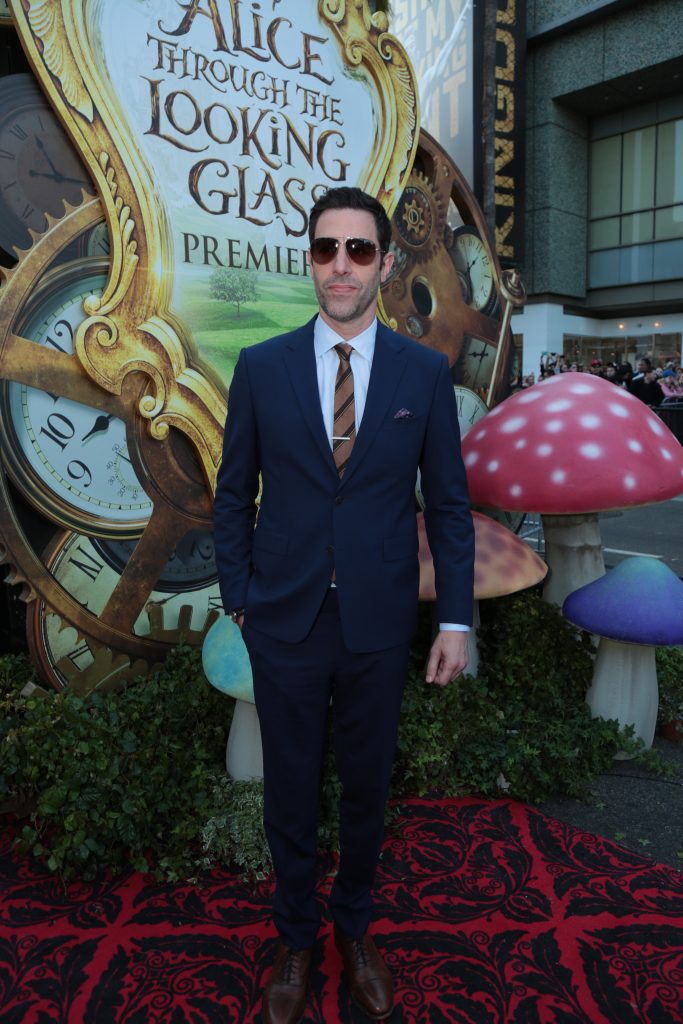
I mean obviously, when you work with someone as brilliant as Sacha you always try to think of ways of getting him back involved in things you’re doing. He and I worked years ago on Borat and Ali G and Bruno. And to do that job you have to create characters that live in the real world. And people aren’t gonna say to you I don’t believe who you say you are. And to his great credit, they never, ever did. I mean people throw us out of stuff for all sorts of different reasons but– but never because they didn’t believe who he was. And so I knew that if you’re going to create a new character for this world, particularly whereby you have iconic characters like the Mad Hatter and Alice and the Red Queen. And we needed to create a character, which is Time. And then Time, of course, is Lewis Carroll’s idea. It’s not my idea. I only borrowed it from him. Lewis Carroll talks about time as a person in the book Alice in Wonderland. Hatter says when he very first meets Alice at the tea party, he’s kinda stuck and he says to her I’ve been stuck here since last month where Time and I quarreled. And I thought that is a brilliant idea for a character. In Wonderland, Lewis Carroll thinks time is not just an idea but a man, a person. And so that would be a very useful character to have in this film. And it felt very right for the movie to have a new character and that it would be Lewis Carroll’s idea. So then I thought that we have a really lovely kind of bad guy in the Red Queen. So you don’t want to do that again.
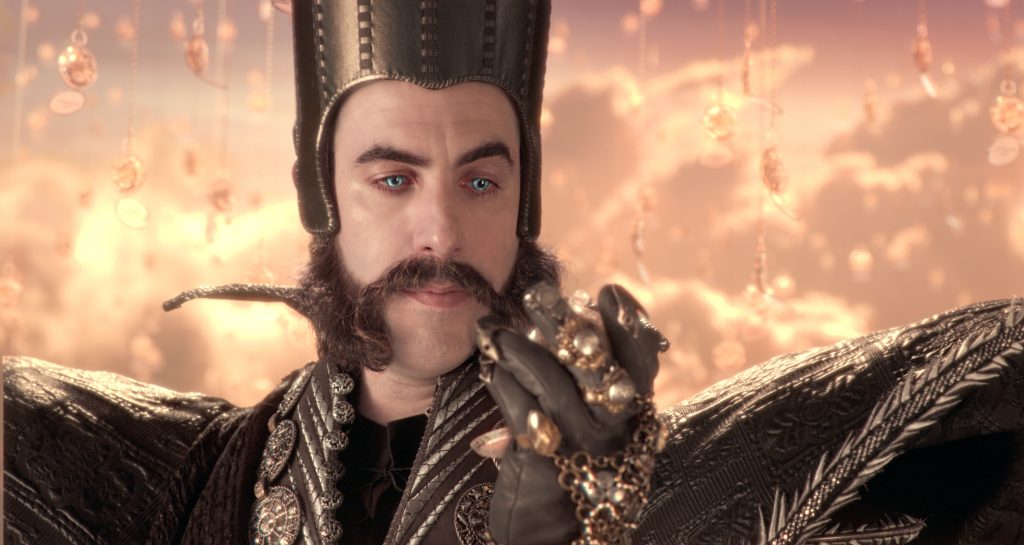
Was he was gonna be is more of a kind of obstacle, like a powerful obstacle to Alice’s situation. Plus I thought that if you’re gonna do a time travel movie, it’d be nice and very British to have to ask permission to have free time. Therefore, when you have a powerful character what’s quite fun is if you undermine them immediately by making it pretty obvious that he’s a fool. Sacha’s very good at playing the sort of over-confident idiot. And that was a very good character choice for him. And if you’re gonna work with Helena and Johnny as he has many times he kinda fits into the universe already. So that was a good start because to raise your performance to match the levels of Johnny Depp and Helena Bonham Carter is not easy to do. So I knew he had it in him. It was just a question of kind of working out what that guy was gonna be like. And then we started talking about the character like we did with Borat and Bruno ’cause obviously those guys we were incredibly in depth with. Like we didn’t do many characters with the Ali G show. We did three characters. But we did them in great depth because we were in the real world. So that you could never have a guy say “this is fake.” So we’d do things like never wash Borat’s suits. So he smelled quite bad. Of course, Borat had been over there for like four weeks doing various bits and pieces. I bet in that morning. And he’s quite weird and difficult. And then Sacha would come in and meet them, and he’d be this quite odd kinda guy. And so I’d try and always maintain a relationship with our interviewee because I felt that they would often look to me. And I go, well, I’m sorry. That is just how he is. I’m sorry. And that’s kind of what the role was for me in that. So I knew the character to Sacha was very good. And in fact, what we used to do in Borat was that my girlfriend, who’s now my wife, her father used to go to business in Kazakhstan. And obviously Kazakhstan, you can buy an amazing amount of stuff. You’d buy newspapers. We’d buy chewing gum and all that sort of stuff. So when we’d go to people’s offices what he would do is he would like– he’d chew gum as Borat. I think he’d open his mouth and put it into a newspaper from Kazakhstan and crumple it up and throw it in the bit so that after we left if anyone ever checked their trash they would find a Kazakh paper plus Kazakh chewing gum in their bin and be completing convincing, like a 360 character. So people totally believed that he was. And that was the kind of depth that we did for the character. So I knew Sacha with me would be– have a fun time creating the new character of Time. Like who he was, how he spoke, how he held himself. Sacha’s a very physical comedian. He like has a very good way of– like if you look at Ali G. And Borat they’re the same guy. But they are completely different. And I remember when we first showed Borat to people, people didn’t know it was Sacha. People thought we’d hired another actor like Borat, which is amazing. And so with Time, again, it’s like how he holds himself, his walk, how he sits, and so, it being a thing whereby we’d already had a lot of English accents. And Sacha could do pretty much anything. And we thought that Time as a concept is a kind of Swiss idea, like clockmakers etceteras. And in Switzerland, there are two languages. There’s French and German. And we thought German was quite precise in its language. And that was a very good thing for Time too. And then we thought, well, you can’t just do a basic, German, you know, you have to do something fun with it. And so we thought like who has an interesting voice who is German? And we came up with our friend– our documentarian friend who Time is basically based upon.
What was the most challenging aspect for you?
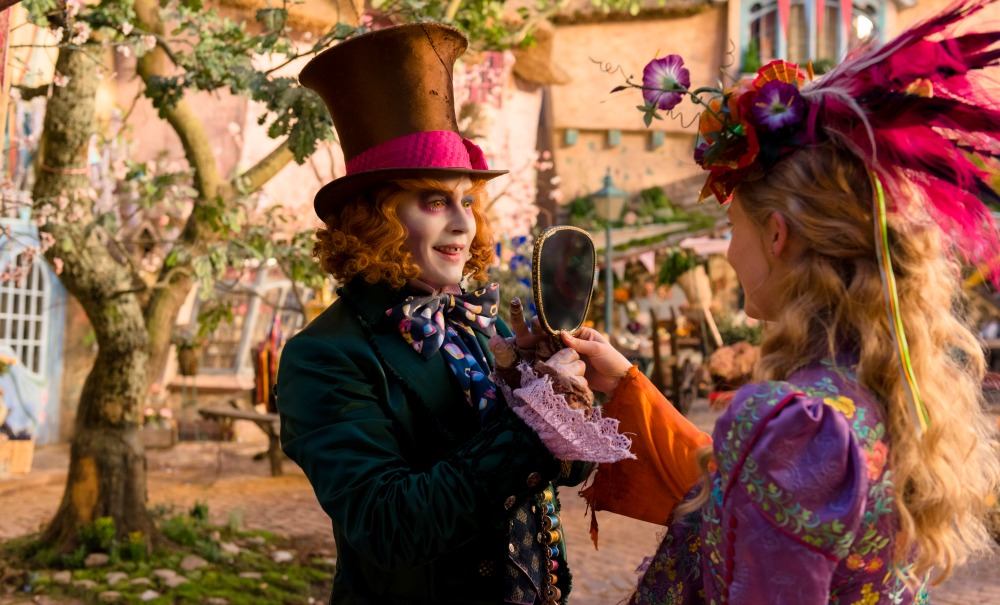 The story is challenging because it’s not the story of the book, which I knew it would never be ’cause I loved the book very dearly. But even as a kid I realized that it’s quite unusual because Lewis Carroll wasn’t that concerned with narrative. He liked imagery ideas. And the book kind of falls in on itself deliberately. Things happen. And then other things happen. And they seem very consequential. It’s only cause and effect. And so I knew that for a film would make an interesting avante guarde movie. But I’m not sure I could do that in this situation. So I knew the story would be a new story. I knew Linda had an idea about the time travel movie based on the characters from before. But at the same time I wanted to pay tribute to the book. The book’s incredibly important. And Lewis Carroll is very important to me. So I wanted to take elements of the book like the backwards room and obviously the looking glass and the characters and the spirit of Lewis Carroll, the idea of something which is fairly complex but not so complex that my eight-year-old daughter wouldn’t understand it. It’s important you understand the story. But also I remember as a kid, I liked working stuff out in a movie. I didn’t want to be given it all straight away. I wanted to be ahead. I wanted to feel like I was ahead of the characters in the movie. And so and this is kind of a puzzle plot in a way. And so I’m hoping even kids may be ahead of the story some ways that when Alice works it out in her head you may already know that stuff, which is great and very satisfying as the kid I think to think I’m cleverer than the people who made this movie. So that’s kind of that was a challenge to try and make a story, which is complex and interesting but not overly so in a way which would be distracting for children.
The story is challenging because it’s not the story of the book, which I knew it would never be ’cause I loved the book very dearly. But even as a kid I realized that it’s quite unusual because Lewis Carroll wasn’t that concerned with narrative. He liked imagery ideas. And the book kind of falls in on itself deliberately. Things happen. And then other things happen. And they seem very consequential. It’s only cause and effect. And so I knew that for a film would make an interesting avante guarde movie. But I’m not sure I could do that in this situation. So I knew the story would be a new story. I knew Linda had an idea about the time travel movie based on the characters from before. But at the same time I wanted to pay tribute to the book. The book’s incredibly important. And Lewis Carroll is very important to me. So I wanted to take elements of the book like the backwards room and obviously the looking glass and the characters and the spirit of Lewis Carroll, the idea of something which is fairly complex but not so complex that my eight-year-old daughter wouldn’t understand it. It’s important you understand the story. But also I remember as a kid, I liked working stuff out in a movie. I didn’t want to be given it all straight away. I wanted to be ahead. I wanted to feel like I was ahead of the characters in the movie. And so and this is kind of a puzzle plot in a way. And so I’m hoping even kids may be ahead of the story some ways that when Alice works it out in her head you may already know that stuff, which is great and very satisfying as the kid I think to think I’m cleverer than the people who made this movie. So that’s kind of that was a challenge to try and make a story, which is complex and interesting but not overly so in a way which would be distracting for children.
So you have such a clear appreciation for Lewis Carroll and his books. And I notice at the beginning of the movie the pocket watch had Carroll. What other ways did you pay tribute?
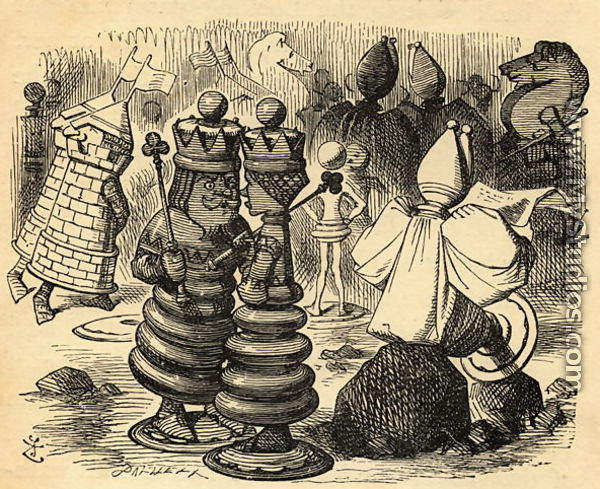
When she goes into the backward room for the first time with the chess match in progress, the chess match is in the original. To the looking glass book that the very beginning of the book prior to the title page is a layout of the chess game in progress. So the chess game in progress in the book is the same chess game in progress in the backward room. So there are those kind of things that are very important to me. And I liked the fact the mantle piece clock in the room is the same mantle piece clock that John Tenniel drew in 1871. So those little touches mean a lot. Because there are things that people are gonna notice. And other things for bigger Alice things. Or when the Red Queen bumps ahead as a child the first thing she sees upon coming round is white roses. And so we always wondered, in my head, what’s up with the white roses thing? Why does she keep changing it to red? And then maybe because in her head there’s a kind of moment where this is a thing that she sees, of the terrible moment in her life. And that’s why there could be no white roses. So, you know that sort of stuff I really like.
ALICE THROUGH THE LOOKING GLASS In Theaters NOW
| Facebook | Instagram | Twitter | Website |
* I attended the #ThoughTheLookingGlassEvent hosted by Disney to share my experience with my readers. All opinions are my own.
- You Have to Remember – 9/11, 20 Years Later - September 11, 2021
- Creating the Perfect Look with a Maxi Dress - October 20, 2020
- Brand Better Giveaway - October 6, 2020


Leave a Reply